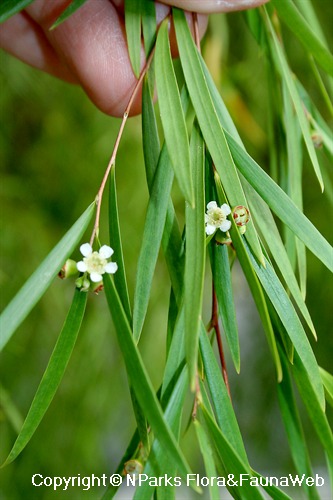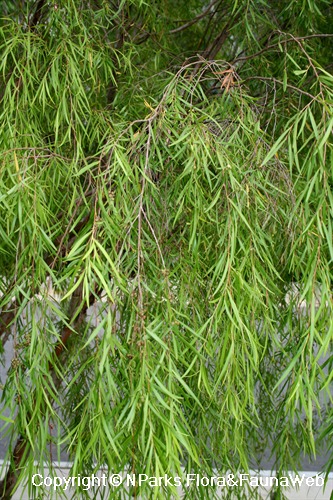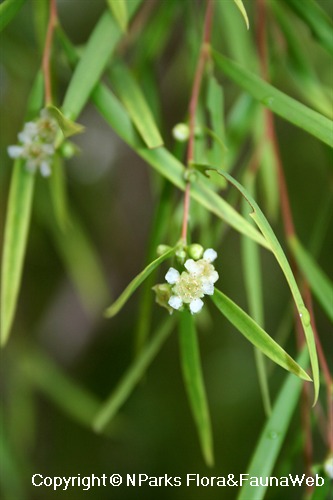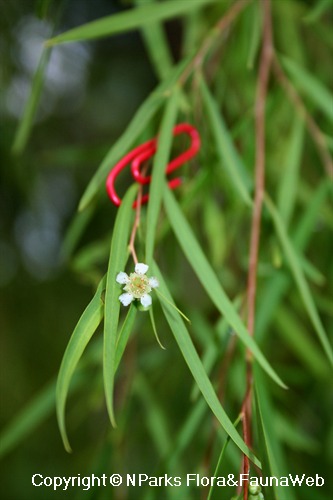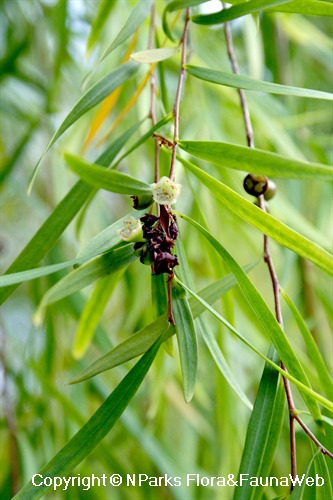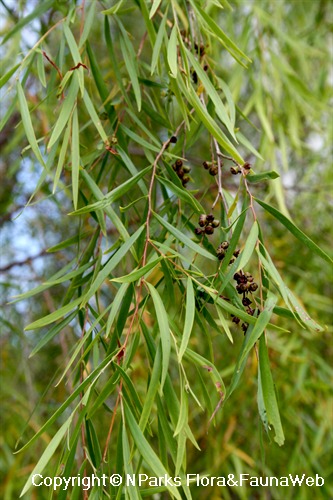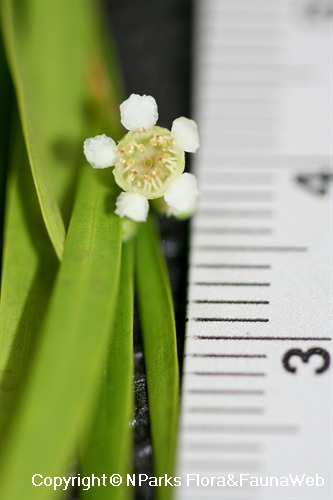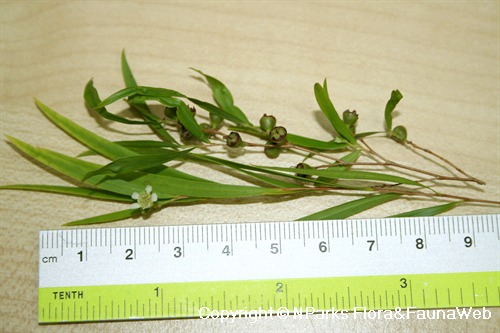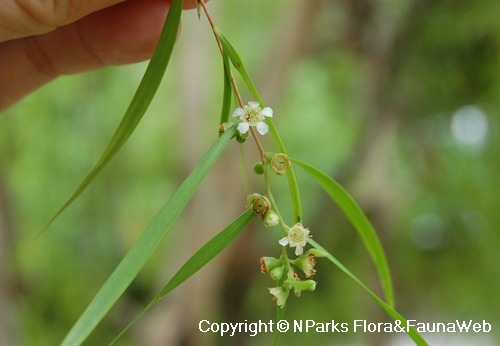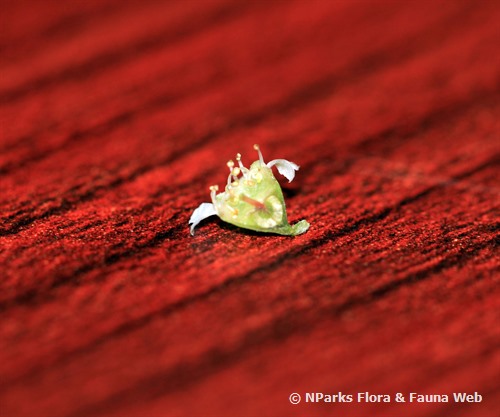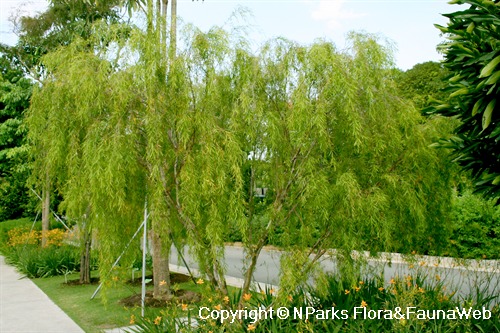
Back
Aggreflorum longifolium subsp. sativum (A.R.Bean) Peter G.Wilson
| Family Name: | Myrtaceae |
| Synonyms: | Leptospermum madidum subsp. sativum A.R.Bean, Leptospermum brachyandrum (Weeping Form) (misapplied), Leptospermum brachyandrum (New Territory form) (misapplied), Leptospermum parviflorum (misapplied) |
| Common Name: | Weeping Tea-Tree |
Name
Classifications and Characteristics
| Plant Division | Angiosperms (Flowering Seed Plants) (Dicotyledon) |
|---|---|
| Plant Growth Form | Shrub, Tree (Small (6m-15m), Shrubby (1m-5m)) |
| Lifespan (in Singapore) | Perennial |
| Mode of Nutrition | Autotrophic |
| Plant Shape | Weeping / Pendulous |
| Maximum Height | 2 m to 4 m |
| Maximum Plant Spread / Crown Width | 2 m to 4 m |
Biogeography
| Native Distribution | Australia (Northern Territory) |
|---|---|
| Native Habitat | Terrestrial (Riverine) |
| Preferred Climate Zone | Sub-Tropical / Monsoonal |
Description and Ethnobotany
| Growth Form | Small tree or big shrub, up to 4m tall and wide, with densely-spreading crown and thin trailing branches, resembling a smaller version of Salix babylonica (Weeping Willow). |
|---|---|
| Trunk | Bark peeling in thin strips, exposing brownish-pink smooth inner bark that ages to creamy-white upon further contact with air. |
| Foliage | Leaves narrowly-linear, 5 - 7cm long by 3 - 4mm wide, held along reddish-brown twigs, emitting a fresh aromatic scent when crushed due to presence of an essential oil rich in monoterpenes (an antioxidant phytochemical also found in citrus fruits and vegetables). |
| Flowers | Freely-produced, small and inconspicuous, 5mm across, 5 white petals. |
| Fruit | Hemispheric in shape, 3 - 4mm across, woody and thin-walled, ripening from green to dark brown, before dehiscing to disperse seeds. |
| Habitat | Endemic to Northern Territory of Australia, naturally distributed in sandstone gorges and along watercourses. |
| Similar | Commonly sold under the misapplied name Leptospermum brachyandrum (New Territory / Pendulous form). The species form Leptospermum brachyandrum has non-pendulous crown. A less commonly-cultivated subspecies Leptospermum madidum ssp. madidum, endemic to Australia's Cape York, has slightly broader leaves and less pendulous crown. |
| Cultivation | Slow-growing. Withstands wet sites and most types of soils. Drought-tolerant when established. Propagate by seeds. Stem and branch cuttings are typically difficult to root. |
| Etymology | Genus epithet 'Leptospermum' derived from Greek terms 'leptos' (slender) and 'sperma' (seed), alluding to the small seeds produced by members of this genus. Species epithet 'madidum' means 'wet' or 'drenched' in Latin, a reference to the tree's natural riverine and moist habitats. Common name 'Tea-tree' derived from practice of Australia's pioneer settlers in boiling the leaves of several species to make a tea-substitute rich in ascorbic acid and antioxidants. |
Landscaping Features
| Desirable Plant Features | Ornamental Foliage, Fragrant (Flowers, Foliage) (Time Independent), Ornamental Trunk |
|---|---|
| Landscape Uses | Riverine, Focal Plant |
| Thematic Landscaping | Water Garden, Naturalistic Garden |
| Plant & Rootzone Preference or Tolerance Remarks | Sandy soils |
Fauna, Pollination and Dispersal
| Seed or Spore Dispersal | Abiotic (Explosive Dehiscence) |
|---|
Plant Care and Propagation
| Light Preference | Full Sun |
|---|---|
| Water Preference | Moderate Water, Lots of Water |
| Plant Growth Rate | Moderate |
| Rootzone Tolerance | Fertile Loamy Soils, Well-Drained Soils, Poor Infertile Soils, Waterlogged Soils (Drains Site), Drought Tolerant |
| Maintenance Requirements | Moderate |
| Propagation Method | Seed, Stem Cutting |
| Propagule Establishment Remarks | Stem and branch cuttings are typically difficult to strike. |
Foliar
| Foliage Retention | Evergreen |
|---|---|
| Mature Foliage Colour(s) | Green |
| Mature Foliage Texture(s) | Smooth |
| Foliar Type | Simple / Unifoliate |
| Foliar Arrangement Along Stem | Alternate |
| Foliar Shape(s) | Non-Palm Foliage (Linear) |
| Foliar Venation | Parallel |
| Foliar Margin | Entire |
| Foliar Apex - Tip | Acuminate |
| Foliar Base | Cuneate |
| Typical Foliar Area | Microphyll ( 2.25cm2 - 20.25 cm2 ) |
| Leaf Area Index (LAI) for Green Plot Ratio | 4.0 (Tree - Dense Canopy) |
Non - Foliar and Storage
| Trunk Type (Non Palm) | Woody |
|---|---|
| Bark Colour(s) | Brownish-pink when fresh, aging to creamy-white upon air exposure. |
| Mature Bark Texture | Peeling / Flaking / Papery, Smooth |
| Stem Type & Modification | Woody |
| Root Type | Underground (Tap Root, Fibrous Root) |
Floral (Angiosperm)
| Flower & Plant Sexuality | Bisexual Flowers |
| Flower Colour(s) | White |
|---|---|
| Flower Symmetry | Radial |
| Flowering Period | Free-Flowering |
| Flowering Habit | Polycarpic |
Fruit, Seed and Spore
| Mature Fruit Colour(s) | Brown |
|---|---|
| Fruit Classification | Simple Fruit |
| Fruit Type | Dehiscent Dry Fruit |
Image Repository
Others
| Master ID | 1705 |
|---|---|
| Species ID | 2998 |
| Flora Disclaimer | The information in this website has been compiled from reliable sources, such as reference works on medicinal plants. It is not a substitute for medical advice or treatment and NParks does not purport to provide any medical advice. Readers should always consult his/her physician before using or consuming a plant for medicinal purposes. |

